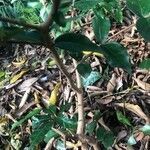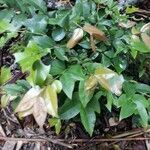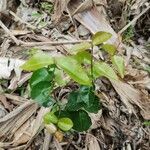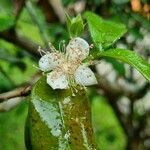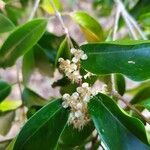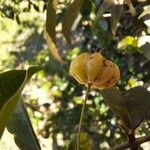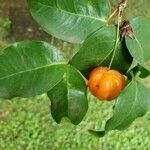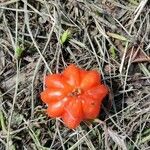Shrubs or trees, to 5 m tall, generally glabrous. Petiole ca. 1.5 mm; leaf blade ovate to elliptic, 3.2-4.2 × 2.3-3 cm, papery, both surfaces dark green, glabrous, and with numerous pellucid glands, secondary veins ca. 5 on each side of midvein, slightly conspicuous, and at an angle of ca. 45° from midvein, intramarginal veins ca. 2 mm from margin, base rounded, slightly cordate, or cuneate, apex acuminate, mucronate, or obtuse. Flowers white, slightly fragrant. Calyx lobes 4, long elliptic, reflexed. Petals white. Berries dark red when ripe, globose, 1-2 cm in diam., 8-ridged, 1-or 2-seeded. Fl. spring.
Much-branched shrub or smalltree 3–10 m tall, leaves ovate, 2–6.3 cm long, 1.3–3.3 cm wide, obtuse or obtusely acuminate at the apex, rounded at the base, glabrous; petiole 2 mm long; flowers solitary or ± 4 in fascicles; pedicels slender, 1.5–2.5 cm long, glabrous, with oblong brown gland-dotted bracts 7 mm long at base.. Calyx-lobes 4 mm long, 1.5–2.5 mm wide, reflexed.. Petals white.. Stamens 50–60.. Fruit green turning orange, bright red, deep scarlet or dark purplish maroon (almost black), oblate, 1.4–2.5 cm diameter, 7–8-ribbed, juicy and edible with either 1 large or 2–3 smaller seeds.
A small tree up to 5-7.5 m high. It is often a much smaller shrub. Branches often develop close to the ground. The branches are thin and wiry. It has attractive oval and pointed leaves. They are dark green and shiny. The leaves are 2.5-6 cm long by 1.5-3 cm wide. New leaves are dark purple or red. The flowers are small and white and the fruit is lobed and red. There is a single large seed inside. The fruit is about 3 cm across. The tree is used as a hedge plant. The flesh of the fruit is edible. There are several named cultivated varieties.
Leaf-lamina up to 6 x 3 cm., ovate or ovate-elliptic, apex bluntly subacuminate, base rounded; lower surface glabrous; lateral nerves in 7–9 pairs, indistinct; petiole 0·2 cm. long.
Flowers 1·5–2·5 cm. long, white, solitary or few together, axillary; pedicels very slender.
Petals c. 0·6 x 0·3 cm., obovate-elliptic, strongly reflexed.
Sepals 4, 0·45 x 0·3 cm., ovate-deltate, strongly reflexed.
Berry 1·5–2·5 cm. in diameter, depressed-globose, crimson.
Shrub or small tree up to 7 m. tall.
Fruit ridged, with smooth red skin.
Style 0·6 cm. long, punctiform.
A shrub or small tree
Stamens 0·5 cm. long.
